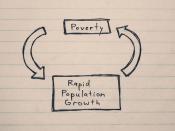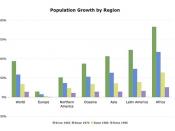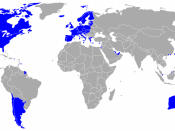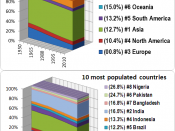Assignment #1 Précis of World Population Beyond Six Billion Throughout this century, the population has grown at a very fast pace. It is predicted that over the next century the population will continue to increase. Majority of the increase in the population will come from less developed regions. As the next century approaches, the population of the world will have different demographic trends. To find out what accounts for these differences, we must discover what causes the population to change. There are many factors linked to population change. These factors include economic growth or decline, public health, education, status of women and family services. The change in one of these factors may cause a change in another. As the population continues to grow there is a major concern about the rapid rate of growth and the large increase in population size.
Before 1900 there was a great struggle for human survival.
Though there were high birth rates, mortality from things such as war, epidemics, and crop failure kept the population from growing quickly. During the 19th century the world population began to develop. This development occurred primarily in the developed countries. The improvement in things like personal hygiene, nutrition, and public sanitation increased human survival. The less developed countries grew slower but they held majority of the world inhabitants.
The large improvement in human survival and the sudden increase in population growth marked the beginning of the demographic transition. Both birth and death rates were at low levels and population growth began to slow down.
As the 20th century began, there was a new stage of demographic transition for the more developed countries. Through proper health care, life expectancy rose to high levels. More infants and young children were surviving do to the health revolution. In 1800, 200 of every 1000 births resulted in death. Early in the century, this dropped to 100 deaths per 1000 births. Death rates dropped quickly and birth rates slowly declined.
By the second half of the century, death from cancer and heart disease was increasing faster amongst the males then the females. Do to this the life expectancy gap between males and females widened. Health conditions deteriorated because there was a lack of health care services. The population growth in the developed countries was halted because of the two decades of low fertility. In the less developed countries, the reduction of death rates after 1950 led to an increase in population growth.
Fertility and mortality determine the size and growth of the world population. Another thing that causes the population to change is migration. Migration flows from the less developed to the more developed countries. Most migration flows from rural to urban areas. There were better job opportunities and public services in the cities than in rural areas. The population shift from rural to urban area causes demographic change. People who move into urban areas usually have higher educational levels, lower fertility, higher incomes, better health and tend to live longer lives then people who live in rural areas. These things lead to the demographic transition to lower mortality and fertility.
When looking at the age and sex profiles of less developed countries, there was an increasing amount of young people. More infants were surviving which contributed to the expanding youth population. In Sub-Saharan Africa 45% of the population is under 15. As the youth population entered the childbearing ages, population continued to grow. Though women were having fewer children, there were more women having children. Few elderly people live in less developed countries. In the developed countries there are many young people but there is a similar amount of older people. The improvements in health care increased the percentage of elderly who survive. Though migration and mortality have a huge affect on a population's age and sex profile, the largest affect is do to fertility rates.
As life expectancy increases and world population continues to grow, there is a common concern with what lies ahead. Will world population stop growing, or will it continue to increase? If the population continues to increase, what will become of the earth?





